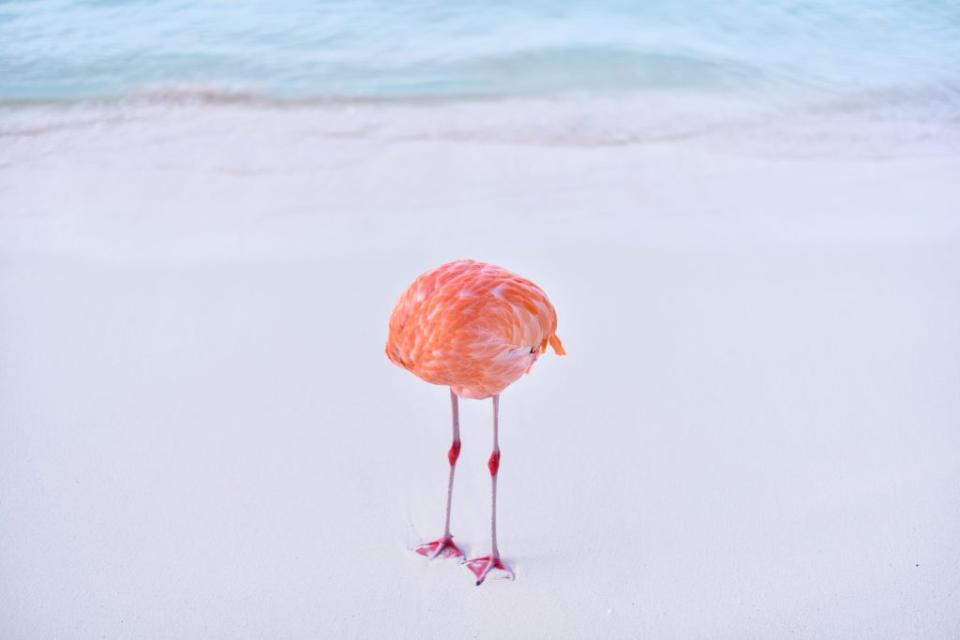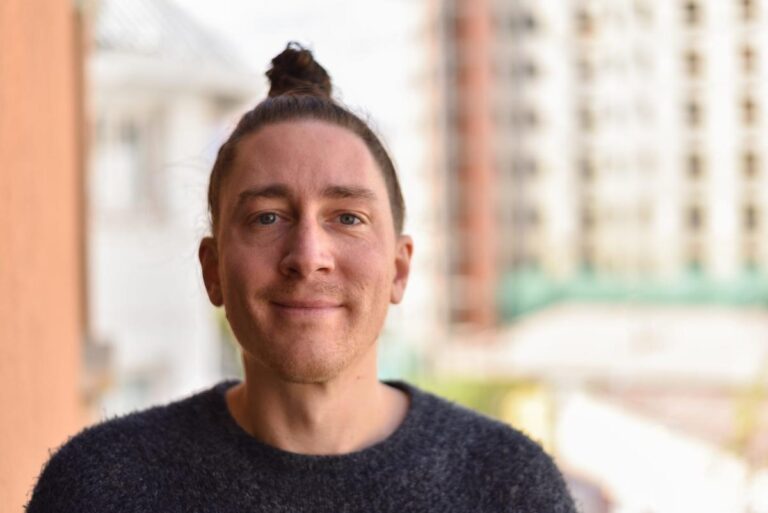As a writer and photographer, the implications of AI-generated content are at least twofold for me. I am not so concerned, however, about the impact this disruptive technology might have on my own work. I have created my own creative language that the machine simply does not speak. What worries me are the tectonic societal shifts that could wipe out livelihoods, professions, industries, and democratic pillars overnight.
Don’t worry, I’m not prophesying the end and I’m not demonizing artificial intelligence. But I do think we need to move the AI debate from public discourse to action as soon as possible. We’re not on the cusp of a tidal wave: we’re in the deep end of the ocean, and there’s no turning back.
Recently I entered my work Pink flamingo (below) in the AI category of the 1839 Awards, a prestigious international photography competition. The added bonus: the image of a seemingly headless flamingo is as real as the belly scratching the bird makes, its neck tucked under its torso. I thought that if I could convince the award’s elite jury with my entry, I would prove that human-made content has not lost its relevance, that Mother Nature and her human interpreters can still beat the machine, and that creativity and emotion are much more than just a series of numbers.


The jury selected my photo from a handful of “real” AI-generated images, putting it in the running for two awards: the jury’s decision and the public vote. In the end, it won over both the jury and the public, winning the public award last week and making it into the jury’s winners. To my knowledge, this photo is the first real photo to win an AI award.
It’s said. Now what?
What is real and what is not
Of course, I felt bad for misleading the jury, but I viewed them as professionals who might find that this attack on AI and its ethical implications outweighs the ethical implications of misleading the viewer—which, of course, is ironic because that’s what AI does. And that’s how this twisted plot began in the first place: in recent years, several AI-generated photos have made international headlines by winning photography competitions they weren’t supposed to enter, highlighting the technology’s increasingly rapid capabilities.
Between these headlines, it occurred to me that I could turn the story inside out, as only a human could. Someone might even say that AI gave me the idea, but then someone else would quickly have to respond that it was humans behind these machines, using them as visual ventriloquists. The fact that this convinced a jury of industry professionals, including members of the The New York TimesPhaidon Press, Getty Images, Centre Pompidou in Paris, Christie’s and Maddox Gallery—reveals several things, and I hope in this precise order:
-
May nature always surpass the machine.
-
That our brains are not yet adapted to the new normal.
-
These AI images have become indistinguishable from representations of reality.
The first question goes without saying. Let me address the other two.
I think the jury is not to blame here. The fact that they didn’t notice my little trick is not a sign of a lack of expertise, but of the existence of psychological bias. They simply weren’t prepared for someone to submit a real photo in the AI category because they didn’t expect it. Why would they?
But that’s the problem: in the same way, as a society, we’re not prepared to question every image, audio file or video we encounter, because historically we haven’t had to. And maybe we shouldn’t. Maybe it would be sad to question everything and everyone that isn’t in front of our eyes. But our critical thinking will have to accelerate the development of AI if we want to stay ahead of the curve, and that’s an individual responsibility that we all share.
As for the AI content being indistinguishable from reality, the message behind my stunt is not so different from the one sent by Berlin artist Boris Eldagsen last year, when he won the Sony World Photo Awards Creative Category with an AI generated image. It’s just that it came from the other end. Same page, different book. We’re not ready for all the implications of AI.
Of course, if AI is used in the right way, it could even empower creatives. It helps Eldagsen do his job. But it could also make many of them redundant, depending on how those creatives adapt and what institutional safeguards we decide to put in place. Some creatives are already using AI to outsource menial tasks and free up resources for their passion projects. Others may have already lost a job here or there because their work seemed redundant to an employer in light of AI-generated content.
There are many nuances between the sensationalist black-and-white scenarios. For example, a cash-strapped startup that is reluctant to hire a graphic designer might use AI to get a free company logo. But that graphic designer just lost a job. And maybe that same startup lets AI generate a generic image for its blog, costing a stock photographer a salary. But then again, that stock photographer may have already switched to AI to produce his content at a much lower cost. It’s complex. It gets slippery when you start talking about less generic content that intentionally or unintentionally misleads the viewer. AI will probably never be able to replace, say, real photos of a newsworthy event. It can, however, produce fake photos to fabricate news that never happened outside of a processor.
Will AI do more good or harm?
Technology is not inherently good or bad. It is nothing in and of itself. How humans use it makes it one thing or another. If we had not dropped the atomic bomb on Hiroshima and instead used it to deter an asteroid from approaching Earth, we might have called it something like the Holy Bomb. In its potential to advance humanity or wreak havoc, AI is no different from many other technologies.
But where we fell behind with its predecessor, social media, this time we should get ahead of change. Don’t get me wrong, I love change. My whole life is change. But change requires adaptation. When social media disrupted the internet, it started by connecting people around the world and facilitating revolutions like the Arab Spring. Great! But it didn’t take long for it to become a tool for spreading fake news that undermines elections and democracies.
AI has the potential to make this all seem like a childish prank, putting a weapon of mass disinformation in the hands of anyone who wants it, without background checks. If we want to be able to report AI-generated content, we will likely have to report it. This responsibility falls on governments and the private sector, and is almost as important as the civil and individual responsibility to think critically and question the obvious. We will need to educate young people to do this.
Reaction to my shot and what it means
As AI-generated content reshapes the digital landscape and sparks increasingly fierce debates about its implications for the future of content and the creators behind it—artists, journalists, and graphic designers—my scheme struck a chord. Media outlets around the world picked up the story, and good old social media amplified it. The overwhelmingly positive response left me, well, overwhelmed. The idea and the statement behind it received enormous support, but nothing surprised and humbled me more than the response I received from the prize organizers themselves.
After revealing the true nature of Pink flamingo to them — and after disqualifying the entry out of fairness to applicants with real AI images — co-founder and CEO Lily Fierman emailed back and noted that she appreciated the powerful message and that it was an important and timely statement.
“We hope this will raise awareness (and send a message of hope) to many photographers worried about AI,” she wrote.
As for me, I hope that my victory will also be a victory for the many creatives, or for anyone who is worried about AI. This technology is here to stay, so I hope that we can adapt and adopt it in a way that is beneficial for all.
Other must-read comments posted by Fortune:
The opinions expressed in Fortune.com commentaries are solely those of the authors and do not necessarily reflect the views and beliefs of Fortune.
This story was originally featured on Fortune.com

